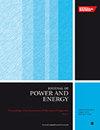气水两相流诱导器特性的实验和计算综合研究
IF 1.1
4区 工程技术
Q3 ENGINEERING, MECHANICAL
Proceedings of the Institution of Mechanical Engineers, Part A: Journal of Power and Energy
Pub Date : 2024-04-03
DOI:10.1177/09576509241240012
引用次数: 0
摘要
本文旨在通过实验和数值模拟相结合的方法,研究气-水条件下诱导器内部的流动特性。气水混合由环形气体混合装置实现,并通过高速成像技术进行可视化。同时,采用剪应力传输(SST)k- ω 模型与 VOF 模型相结合来研究气相分布。数值模拟的诱导剂能量特征和内部气相分布与实验数据非常吻合。结果表明,诱导器内部的气液混合流表现出三种流动模式:波浪流、气泡流和堵塞流。在波浪形流动中,叶片表面出现一系列波浪形结构,叶片边缘附近出现气泡。从波浪流到气泡流,可观察到叶片表面均匀的气泡流和叶片边缘附近螺旋状的条形气泡。对于堵塞流,气泡积聚形成子弹状堵塞,叶片边缘附近的条状气泡更加明显。在诱导器的同一轴向位置,气相比例随着流量系数的增大而增大,从而影响诱导器的性能。当流型由波浪流变为塞流时,压力脉动的主频幅值逐渐升高。本文章由计算机程序翻译,如有差异,请以英文原文为准。
A combined experimental and computational investigation of an inducer’s characteristics with gas-water two-phase flow
The objective of the paper is to investigate the internal flow characteristics inside the inducer under the gas-water condition using a combination of experiment and numerical simulations. Gas-water mixing is achieved by an annular gas mixing device and visualized by high-speed imaging technology. Meanwhile, the shear stress transport (SST) k- ω model coupled with the VOF model is applied to investigate the gas phase distribution. Numerically simulated inducer energy characteristics and internal gas-phase distribution are in good agreement with experimental data. The results show that the mixed gas-liquid flow inside the inducer exhibits three flow patterns: wavy flow, bubbly flow, and plug flow. For the wavy flow, a series of wavy structures on the blade surface and gas-pocket bubbles near the blade rim are observed. From wavy flow to bubbly flow, uniform bubble streams on the blade surface and spiraling strip bubbles near the edge of the blade are observed. For plug flow, bubble accumulation results in a bullet-shaped plug, and the strip-shaped bubbles near the blade rim are more obvious. In the same axial position of the inducer, the proportion of gas phase is increasing as the flow coefficient increases, thus affecting the inducer performance. The main frequency amplitude of the pressure pulsations gradually rise when the flow pattern changes from wavy to plug flow.
求助全文
通过发布文献求助,成功后即可免费获取论文全文。
去求助
来源期刊

CiteScore
3.30
自引率
5.90%
发文量
114
审稿时长
5.4 months
期刊介绍:
The Journal of Power and Energy, Part A of the Proceedings of the Institution of Mechanical Engineers, is dedicated to publishing peer-reviewed papers of high scientific quality on all aspects of the technology of energy conversion systems.
 求助内容:
求助内容: 应助结果提醒方式:
应助结果提醒方式:


